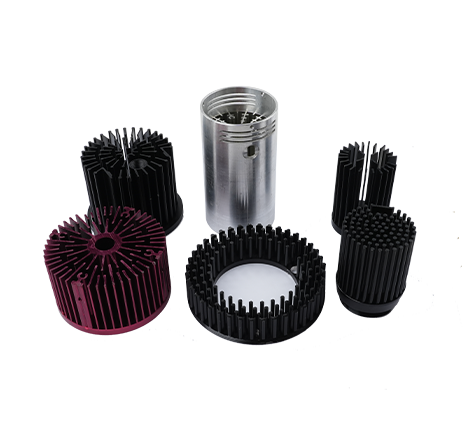

Dongguan dry Xing Yuan hardware products Co., LTD
Phone: 13723735921
Address: No. 462 Houda Road, Dalingshan Section, Dalingshan Town, Dongguan City
E-Mail: qxywj@qxyboom.com
Website: www.dgqxy.cn
2024-09-19 14:59:36
Visit:
Optimizing the airflow design of profile radiators is the key to improving heat dissipation efficiency. Here are some main methods and considerations:
1. Geometry optimization:
Design the shape and layout of fins to increase heat dissipation area and guide airflow. For example, using wavy or serrated fins can enhance turbulence and improve heat exchange efficiency.
Adjust the spacing between fins to ensure smooth airflow without creating excessive resistance, while maintaining sufficient heat dissipation surface area.
Use fluid dynamics software for CFD (Computational Fluid Dynamics) simulation to optimize the three-dimensional structure of the radiator and obtain the optimal airflow distribution.

2. Application of heat pipes:
Introducing heat pipe technology can quickly transfer heat away from the heat source and disperse it to a wider area of the radiator, thereby improving overall heat distribution and airflow efficiency.
3. Surface treatment:
Special treatment is applied to the surface of the radiator, such as anodizing, plating, or coating, to improve its thermal conductivity and corrosion resistance, while reducing air friction and improving airflow.
Surface texture design, such as micro nano structures, can increase the contact area of airflow and further improve heat exchange efficiency.
4. Air duct design:
The installation position of the radiator and the layout of the system air duct should take into account the direction and speed of the airflow, avoid dead corners and vortex areas, and ensure that the airflow evenly covers the surface of the radiator.
Install guide plates or air ducts in front and behind the radiator to direct airflow towards the radiator and reduce thermal resistance caused by airflow bypassing.
5. Fan selection and configuration:
Choose the appropriate fan and determine the number, position, and speed of fans based on the size and heat load of the radiator to provide sufficient airflow and static pressure.
The fan should match the airflow characteristics of the radiator to avoid excessive noise and unnecessary energy waste.
6. Testing and optimization:
Implement thermal performance testing, including measuring the temperature distribution, airflow velocity, and pressure loss of the radiator, to evaluate the effectiveness of the design.
Adjust design parameters based on test results, which may include modifying the thickness, spacing, shape of fins, or the overall contour of the heat sink.
7. Intelligent control:
By introducing temperature sensors and intelligent controllers, the fan speed can be dynamically adjusted based on real-time temperature data, achieving more precise airflow control and energy management.
Through these methods, it is possible to effectively optimize the airflow design of profile radiators, improve heat dissipation efficiency, reduce operating noise, and reduce energy consumption. In practical applications, these optimization measures often need to be combined to achieve the best heat dissipation effect.

Focus on cold forging radiator, cold forging parts, cold forging IGBT copper and aluminum cooling module, super power radiator and other products.
+86-0769-33287786
13723735921
No. 462 Houda Road, Dalingshan Section, Dalingshan Town, Dongguan City
Copyright: Dongguan dry Xing Yuan hardware products Co., LTD
Service support: Huashang Network
